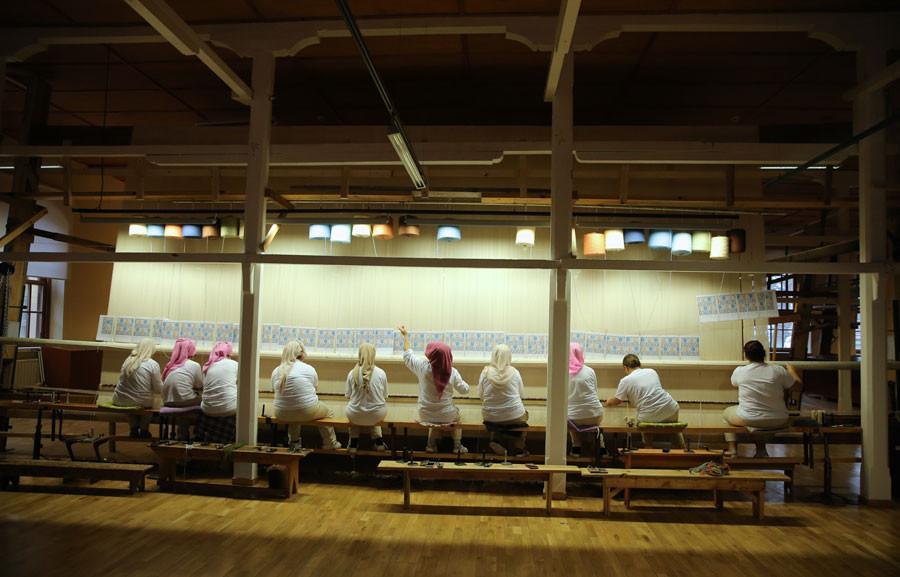Home of world-famous Hereke carpets
KOCAELİ – Anadolu Agency

The Grand National Assembly of Turkey (TBMM) National Palaces Hereke Carpet and Silk Weaving Factory has been producing silk furnishing for palaces and mansions for 176 years while keeping its feature as a “museum factory.”
One of the most important elements of the palace life in the last century of the Ottoman Empire, the Hereke Weaving Factory was founded in 1843 during the reign of Sultan Abdülmecid in order to revitalize the art of weaving.
The factory, manufacturing carpets to meet the need for upholstery and drapery of the palaces, started weaving carpets in 1891.

Under the auspices of Abdulhamid II, the production process started with the masters from the Anatolian cities of Sivas, Ladik and Manisa. The masters first created design patterns given by the palace which were later developed. The unique Hereke style was then revealed.
Thus, carpet-weaving units were added to the Hereke Weaving Factory and the foundations were laid for Hereke’s world-famous carpet weaving.
The most outstanding products of the Hereke Weaving Factory were used in the decoration of palaces and pavilions, which were the showcase of the Ottoman industry, as well as in the European palaces through gifts given to the members of foreign dynasties.
The factory became a world-renowned brand half a century after its establishment and won awards in international exhibitions in Paris, London, Vienna, Lyon, Brussels and Turin.
Hereke at the same time was recorded as the factory weaving Turkey’s largest carpet. The 468-square-meter carpet that the factory weaved 120 years ago for the ceremonial hall of the Yıldız Şale Mansion is still among the world’s largest carpets.
The 124-square-meter Hereke carpet, which adorns the floor of a hall in the Dolmabahçe Palace, where the holiday ceremonies were held during the Ottoman period, attracts the attention of thousands of local and foreign tourists today.
The Hereke Weaving Factory, which served under the roof of Sümerbank during the Republican period, was attached to the National Palaces Administration in 1995 under the Privatization Law.
The factory, which continues its production as a museum-factory today, also hosts joint works with national palaces’ researchers.
[HH] 360,000 knots per square meter
Speaking to state-run Anadolu Agency, TBMM National Palaces Hereke Carpet and Silk Weaving Factory Director Emine Günaydın said the factory’s productions were world-famous.
Stating that Hereke gained its original style in the Abdulhamid era, Günaydın said that the high quality of the products made it a brand.
“Hereke wool carpet has 360,000 knots per square meter,” said Günaydın, adding: “This density of knots improves both quality and allows for making curved patterns as the pixels are small. This allows making very fine patterns. That’s why the Hereke classic emerged. The world’s best quality carpet is the Hereke carpet. New-era silk carpets have 1-2.5 million knots, but Hereke wool carpets have the highest-density knots as well as the highest quality.”
[HH] Carpet becomes more beautiful as it is used
Günaydın said that the Hereke carpet had many unique features.
“Hereke carpet is known to be ageless. The fact that the density of knots is very high, the quality of the carpet provides long-lasting life. Patterns have also contributed to being a world brand. Carpets become more beautiful as people walk on it; the colors are shining and they are getting a more beautiful look. This feature is unique to the Hereke carpet only. The Turkish knot we call Gördes is used in the Hereke carpet. This makes it durable.”
Indicating that a person can weave a square meter carpet every three months, Günaydın said that it was a labor-intensive work as it has 360,000 knots in each square meter.
She said that visitors of the factory resembled the sound of weaving to a musical.
A velvet fabric weaver in the factory, Hasan Kahraman said that velvet fabrics were used in the rooms of the sultans, adding: “There are three-four people who are known to do this in the world. This work is hard and labor-intensive. I can weave 22 centimeters a day.”
















